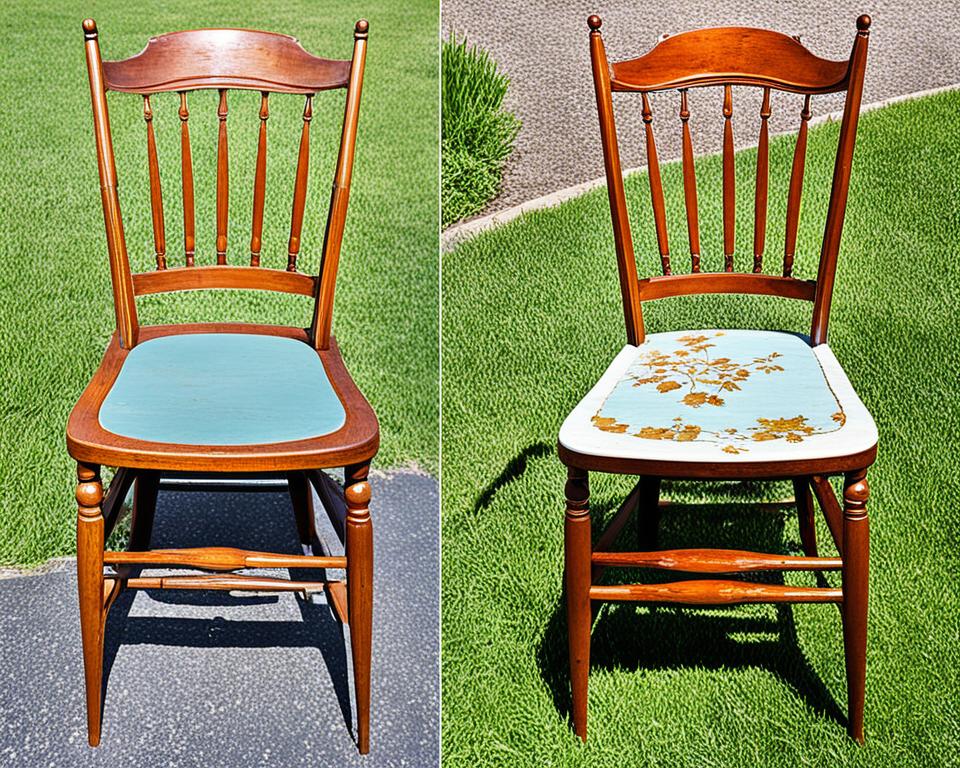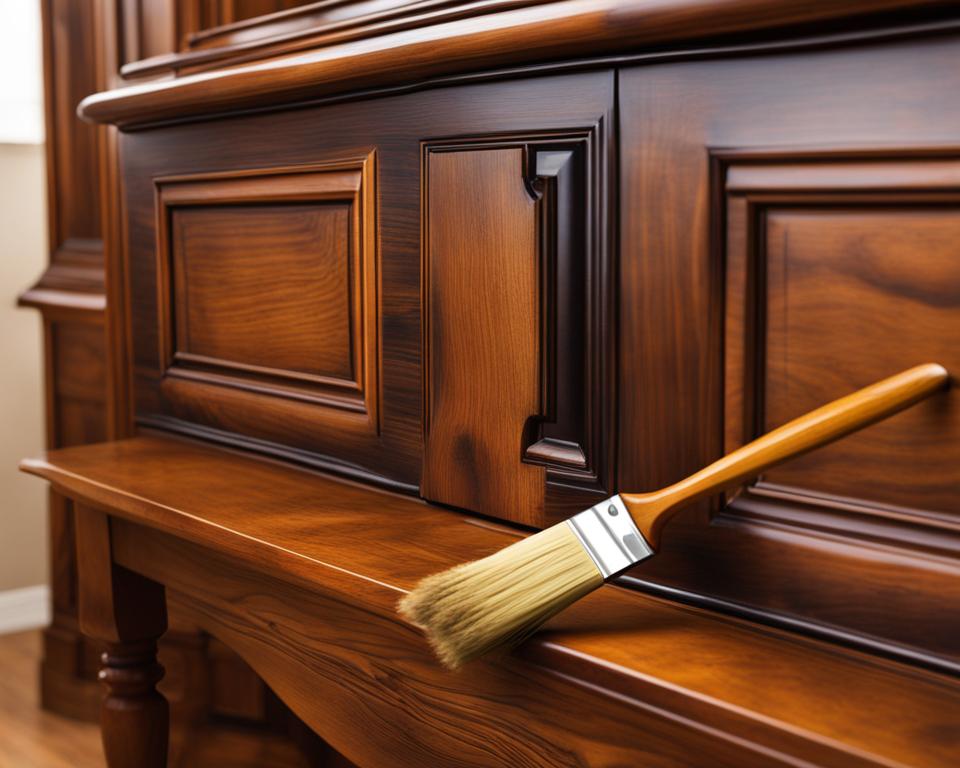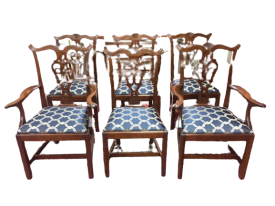Refinishing furniture can be a transformative process, breathing new life into old pieces and preserving their beauty for years to come. At This Old House, we understand the satisfaction that comes from restoring and refinishing furniture, whether it’s a beloved family heirloom or a unique thrift store find. Our comprehensive guides on refinishing furniture provide you with the knowledge and techniques needed to achieve stunning results.

Our refinishing furniture guides cover a wide range of topics, including furniture restoration techniques and step-by-step instructions on how to refinish antique furniture. Whether you’re a seasoned DIY enthusiast or a beginner looking to embark on your first refinishing project, our guides are designed to empower you with the knowledge and skills necessary to tackle any furniture restoration endeavor.
Key Takeaways:
- Refinishing furniture is a rewarding and transformative process that can bring old pieces back to life.
- Our comprehensive guides cover everything from furniture restoration techniques to refinishing antique furniture.
- Whether you’re a beginner or an experienced DIY enthusiast, our guides provide step-by-step instructions to help you achieve stunning results.
- Preserve and restore the beauty of your family heirlooms or give new life to thrift store finds with our refinishing furniture guides.
- Gain the knowledge and skills necessary to confidently tackle your own furniture restoration projects.
Selecting the Right Finish
Before you begin refinishing furniture, it’s important to choose the right finish that suits both your style preferences and the durability required for the piece. There are various wood finishes available, each with its own characteristics and benefits.
Consider the following factors when selecting a wood finish:
- Frequency of use: If the furniture will be heavily used or exposed to wear and tear, a durable finish is essential.
- Exposure to elements: Outdoor furniture or pieces in areas with high humidity or direct sunlight require finishes that can withstand these conditions.
- Desired appearance: Think about the aesthetic you want to achieve. Do you prefer a glossy or matte finish? Light or dark colors?
This Old House provides expert guidance on choosing the best wood finish for your furniture based on these considerations. They offer detailed information on different types of wood finishes, including their pros and cons, so you can make an informed decision.
For a better understanding, here’s a comparison of glossy and matte finishes:
| Glossy Finish | Matte Finish |
|---|---|
| Provides a shiny and reflective surface | Offers a more subtle and understated look |
| Tends to highlight imperfections or scratches more visibly | Can help conceal minor flaws |
| Generally requires more maintenance for preserving its shine | May require less maintenance and can be easier to touch up |
Choosing the right finish is crucial in achieving a successful furniture refinishing project. It not only enhances the appearance but also provides protection and longevity to your treasured pieces. Remember to consider the intended use, exposure to elements, and your desired aesthetic when making your selection.
Cleaning the Furniture
Proper cleaning is essential before refinishing furniture. To prepare your piece for the next steps, start with a basic cleaning using the following materials:
- A tack cloth
- Dish soap
- Warm water
Begin by using a tack cloth, which is a lint-free paint rag, to remove dirt and sticky substances from the furniture surface. Gently wipe the furniture with the tack cloth, ensuring thorough coverage.
Next, prepare a solution of dish soap and warm water. Dip a sponge into the mixture, wring out excess liquid, and gently wipe the entire surface of the furniture. This will help remove any remaining dirt and grime.
Afterwards, rinse the furniture with a damp sponge to remove any soap residue. Finally, dry the furniture with a microfiber towel to ensure it is completely dry before moving on to the next steps.
Proper cleaning is the foundation for a successful furniture refinishing project. By removing dirt and grime, you create a clean canvas for the subsequent steps of the process. Take the time to perform a thorough cleaning to achieve the best results.
Assessing the Condition
Before refinishing furniture, it’s important to assess its condition and determine if any repairs are needed. During this step, I carefully inspect the piece for marks, flaws, and any other issues that may require additional attention. This Old House recommends checking for the following:
- Scratches or dents
- Cracks or splits
- Loose joints or broken parts
If any repairs are necessary, I rely on trusted supplies such as epoxy putty and wax filler to restore the furniture’s integrity and aesthetics. Epoxy putty is a versatile solution that can be used to fill in both small and large flaws, providing a strong and durable repair that can withstand everyday use. Wax filler, on the other hand, is ideal for fixing small to medium-sized holes, giving the furniture a smooth and seamless finish.
Here’s a closer look at how these repair supplies can be used:
Repairing with Epoxy Putty
Epoxy putty is a two-part clay-like substance that hardens into a strong and durable finish. To use epoxy putty for repairs, follow these steps:
- Clean the damaged area and remove any loose debris.
- Take equal parts of the epoxy putty and mix them together until well blended.
- Apply the mixed epoxy putty to the damaged area, shaping and smoothing it with your fingers or a small tool.
- Allow the epoxy putty to dry and harden according to the manufacturer’s instructions.
- Sand the repaired area to achieve a seamless finish.
Fixing Holes with Wax Filler
Wax filler is a soft and pliable material that can be used to fill small to medium-sized holes in wood furniture. To fix holes using wax filler, follow these steps:
- Clean the area around the hole and remove any loose particles.
- Select a wax filler that matches the color of the wood.
- Using a putty knife or a similar tool, press the wax filler into the hole, ensuring it fills the void completely.
- Smooth the surface of the wax filler using the putty knife or your fingers.
- Remove any excess wax filler and let it dry.
- Lightly sand the repaired area to achieve a seamless blend with the surrounding wood.
It’s essential to address any repairs before proceeding with the refinishing process. By carefully assessing the condition and utilizing supplies like epoxy putty and wax filler, you can ensure that your furniture is in top shape and ready for its transformation.
Removing the Old Finish
When refinishing furniture, it’s essential to remove the old finish to create a clean surface for the new stain or paint. This Old House provides detailed instructions on two effective methods of removing paint and varnish: sanding and using chemical strippers.
Sanding
If you prefer a hands-on approach, sanding is a tried-and-true method for paint and varnish removal. Start with coarse-grit sandpaper to strip away the existing finish. This rough sandpaper will effectively remove the top layers, revealing the bare wood underneath.
Once you’ve cleared away the majority of the old finish, switch to medium-grit sandpaper to remove any remaining patches. The medium-grit sandpaper will help smooth out the surface, preparing it for the next refinishing steps. Finally, use fine-grit sandpaper to achieve a uniformly smooth surface.
Chemical Strippers
If you’re looking for a quicker and more efficient method, chemical strippers are an excellent option for paint and varnish removal. These powerful solutions penetrate the layers of old finish, softening them for easy removal.
When using chemical strippers, it’s important to follow the manufacturer’s instructions carefully. Apply the stripper evenly, using a brush or rag, and allow it to sit for the recommended amount of time. The old finish will start to bubble and loosen, making it easy to scrape away with a putty knife or stripping tool.
| Method | Pros | Cons |
|---|---|---|
| Sanding |
|
|
| Chemical Strippers |
|
|
When deciding between sanding and chemical strippers, consider your preferences, the condition of the furniture, and the type of finish you’re removing. In some cases, a combination of both methods may be necessary to achieve the desired results.
Remember to wear protective gear, such as gloves and a mask, when using chemical strippers or sanding to ensure your safety. Additionally, proper ventilation is crucial to minimize the inhalation of dust or fumes.
Sanding the Furniture
After removing the old finish, sanding the furniture is a crucial step to achieve a smooth surface for refinishing. The right sanding technique and sandpaper grit can make all the difference in creating a flawless final result.
Using Coarse to Fine Grit
When it comes to sanding furniture, it’s essential to progress from coarse to fine grit sandpaper. Start with a coarse grit, such as 80 or 100, to strip away any residual finish and remove imperfections. This initial sanding creates a clean canvas for the next steps.
Once you’ve stripped away the old finish, switch to a medium-grit sandpaper, such as 150 or 180. This will help to remove any remaining patches or uneven areas, ensuring a smooth and even surface.
Finally, it’s time to use a fine-grit sandpaper, typically around 220 to 240 grit. This final sanding helps to achieve a uniformly smooth surface, free of scratches and imperfections.
Tips for Effective Sanding
- Always sand in the direction of the wood grain to prevent scratches.
- Apply even pressure while sanding to avoid uneven surfaces.
- Periodically check the surface with your hand to ensure smoothness.
- Dust off the furniture between sanding grits to maintain cleanliness.
Remember, sanding is a critical step in creating the perfect foundation for refinishing. Taking the time to sand properly will ensure a smooth surface and a professional-looking final result.
“Sanding is the key to achieving a smooth and flawless finish when refinishing furniture. Be patient and take your time, starting with coarse sandpaper and gradually progressing to finer grits. The effort you put into sanding will pay off in the end with a beautifully restored piece of furniture.” – This Old House
Sources:
- This Old House: How to Refinish Furniture
Sealing the Wood
Sealing the wood is a critical step in the furniture refinishing process. It not only provides essential protection but also creates a smooth and durable base for applying stain or paint. To achieve the best results, follow the step-by-step instructions below:
- Start by using a sealant specifically designed for wood. This will help to prevent moisture damage, enhance the longevity of the finish, and ensure a beautiful end result.
- Before sealing the wood, thoroughly inspect it for any cracks or holes. These imperfections can impact the final appearance and overall integrity of the piece.
- To address cracks or holes, fill them in with a matching wood filler. This will not only restore the surface to its original smoothness but also ensure the final finish is seamless.
- After applying the sealant and filler, allow sufficient time for them to dry completely according to the manufacturer’s instructions.
- Once dry, lightly sand the sealed and filled surface using fine-grit sandpaper. This will further smooth out any imperfections and create a suitable surface for staining or painting.
Sealing the wood is a crucial step that prepares the furniture for the final transformation. By following these guidelines and using the right products, you can set a solid foundation for the next stages of the refinishing process.

Staining or Painting
Once the wood is sealed, it’s time to apply the desired wood stain or paint. Choosing the right finish is essential to achieve the desired look and protect the furniture. This Old House offers expert guidance on selecting the perfect wood stain or paint for your project.
Tips for Choosing the Right Wood Stain or Paint
- Consider the desired color: Wood stains come in a variety of shades, from light to dark, allowing you to enhance the natural beauty of the wood. On the other hand, paint offers endless color options to match your personal style and home decor.
- Think about the type of finish: If you prefer a natural look with visible wood grain, opt for a wood stain. Paint, on the other hand, provides a smooth and opaque finish, ideal for covering imperfections or adding a pop of color.
- Assess the durability: Consider the furniture’s purpose and location. If it will be exposed to heavy use or outdoor conditions, choose a durable wood stain or paint designed for such environments.
Before applying the wood stain or paint, it’s essential to prepare the surface properly. Ensure that the wood is clean, smooth, and free from any dust or debris. Additionally, it’s recommended to do a test on a hidden area of the furniture to ensure the desired color and finish are achieved.
When applying the wood stain or paint, it’s important to use proper techniques to achieve a smooth and even result. This Old House shares valuable tips for application:
- Apply thin coats: Rather than applying a thick layer of stain or paint, it’s best to start with thin coats. This allows for better control and helps prevent drips or uneven color.
- Let each coat dry completely: Before applying subsequent coats, make sure to let each layer of stain or paint dry thoroughly. This ensures proper adhesion and prevents smudging or damage to previous layers.
- Assess the color after each coat: Once a coat has dried, step back and assess the color. If the desired shade or coverage hasn’t been achieved, additional coats may be necessary.
Remember, patience is key when applying wood stain or paint. Take your time, follow the instructions on the product, and enjoy the process of transforming your furniture.
| Advantages of Wood Stain | Advantages of Paint |
|---|---|
| Enhances natural wood grain | Unlimited color options |
| Provides a warm and rustic look | Offers a smooth and opaque finish |
| Allows wood to breathe | Covers imperfections or stains |
| Penetrates deep into the wood | Durable and long-lasting |
Applying Wood Finish
Once you have stained or painted your furniture, the next crucial step is applying a wood finish to protect and enhance the final result. At This Old House, we recommend using either a paint brush or a cotton rag to apply the wood finish evenly across the surface of the furniture.
Allow the wood finish to dry completely before assessing if a second coat is necessary. This ensures that the finish adheres properly and creates a durable layer of protection. It’s important to note that different wood finishes have varying drying times, so be sure to follow the manufacturer’s instructions for the specific product you’re using.
To achieve a pro-grade finish, take the time to sand between coats. Use fine-grit sandpaper to gently smooth any imperfections or raised grain that may have occurred during the application. This step not only ensures a smooth and flawless finish but also allows subsequent coats to adhere better, resulting in a more professional look.
Remember, patience is key when applying a wood finish. Take your time, follow the instructions, and allow each coat to dry thoroughly before moving on to the next step. This attention to detail will guarantee a beautiful and long-lasting result.
Expert Tip: Sanding between coats
“Sanding between coats is crucial for achieving a professional-grade finish. It smoothes out any imperfections, allowing subsequent coats to adhere better. Use a fine-grit sandpaper and apply light pressure to avoid removing too much of the previous coat.”
Applying a wood finish is the final touch that brings your furniture refinishing project to completion. With the right tools, techniques, and a little bit of patience, you can achieve a pro-grade finish that not only protects but also enhances the beauty of your furniture.
Home Depot Mobile App
The Home Depot Mobile App is a must-have for anyone embarking on a furniture refinishing project. With this user-friendly app, you can conveniently locate all the products you need for the task at hand. Whether you’re searching for wood finishes, sandpapers, or sealants, the Home Depot Mobile App makes it easy to find the items you’re looking for. No more wandering through aisles or struggling to navigate the store – the app streamlines the shopping experience.
One of the app’s standout features is its ability to help you check inventory in real-time. Before making the trip to the store, simply use the app to verify if a particular product is available. This saves you time and ensures you purchase the necessary items without any surprises. You can also check product reviews and ratings, allowing you to make informed decisions about which items to choose for your furniture refinishing project.
In addition to browsing and locating products, the Home Depot Mobile App offers a range of other helpful features. You can access instructional videos and tutorials right from your mobile device, ensuring you have the guidance you need throughout the refinishing process. The app also allows you to create shopping lists and save your favorite products for future reference.
With its intuitive interface and comprehensive functionality, the Home Depot Mobile App is an indispensable companion for anyone undertaking a furniture refinishing project. It simplifies the process of finding and purchasing all the necessary supplies, saving you time and making your DIY journey more enjoyable.
Conclusion
Refinishing furniture is a wonderful way to bring new life to your cherished pieces and preserve their beauty for years to come. Whether you’re restoring a beloved family heirloom or transforming a thrift store find into a stunning piece, this DIY project is both rewarding and fulfilling.
By following the comprehensive refinishing furniture guides provided by This Old House, you can confidently tackle your own restoration projects. Their step-by-step instructions cover everything from selecting the right finish to applying wood stain or paint, ensuring that you achieve the best possible results.
So why not embark on your own furniture refinishing journey? Restore and preserve your favorite pieces while unleashing your creativity and adding a personal touch to your home. With the guidance and knowledge shared by This Old House, you’ll be able to transform old furniture into beautiful works of art with your own hands.
FAQ
What are some tips for selecting the right finish for my furniture?
Consider factors such as frequency of use, exposure to heat and liquids, and your preference for dark or light, glossy or matte finish. This Old House provides guidance on choosing the best wood finish based on these considerations.
How do I clean my furniture before refinishing?
Start with a basic cleaning using a tack cloth and a mixture of dish soap and warm water. The tack cloth helps remove dirt and sticky substances. Rinse the furniture with a damp sponge and dry it with a microfiber towel.
How do I assess the condition of my furniture before refinishing?
Check for marks and flaws that may require repairs. This Old House suggests using epoxy putty for small and large flaws, and wax filler for small to medium-sized holes.
What are the different methods for removing the old finish?
You can use sanding or chemical strippers. Sanding helps achieve a smooth surface, while chemical strippers are efficient in removing paint and varnish. This Old House provides detailed instructions on how to use these techniques effectively.
How do I sand the furniture before refinishing?
Use coarse sandpaper to strip away residual finish, then switch to medium-grit sandpaper to remove remaining patches. Finally, use fine-grit sandpaper to ensure a uniformly smooth surface. This Old House provides tips on using sandpaper effectively for the best results.
What is the process of sealing the wood?
Apply a sealant and fill cracks or holes with a matching filler. After applying the sealant, smooth the surface with fine-grit sandpaper to prepare it for staining or painting.
How do I stain or paint my furniture?
Choose the right wood stain or paint and follow application techniques suggested by This Old House. Let each coat dry completely before applying another layer. Assess the color after each coat to determine if additional coats are needed.
What is the process of applying wood finish?
Use a paint brush or cotton rag to apply the finish, allowing it to dry completely before assessing if a second coat is necessary. This Old House provides tips on achieving a professional-grade finish, including sanding between coats to smooth any imperfections.
How can the Home Depot Mobile App assist with refinishing furniture?
The Home Depot Mobile App helps locate products and check inventory, making it easier to find everything needed for the refinishing process. This Old House encourages readers to download the app for a convenient shopping experience.
Why is refinishing furniture a rewarding DIY project?
Refinishing furniture allows you to restore and preserve cherished pieces or transform thrift store finds into stunning pieces. This Old House provides refinishing furniture guides to help readers tackle their own furniture restoration projects.







